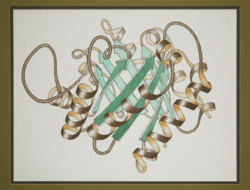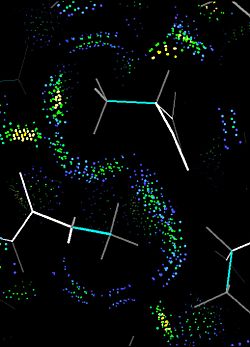Jane S. Richardson facts for kids
Quick facts for kids
Jane S. Richardson
|
|
|---|---|

Richardson in 2002
|
|
| Born | January 25, 1941 Teaneck, New Jersey, U.S.
|
| Education | Swarthmore College Harvard University |
| Known for | Ribbon diagram, structure validation |
| Spouse(s) | David C. Richardson |
| Awards | MacArthur Fellowship (1985), Alexander Hollaender Award in Biophysics (2019) |
| Scientific career | |
| Fields | Structural biology, Biophysics |
| Institutions | Duke University |
Jane Shelby Richardson is an American scientist who changed the way we see the building blocks of life. She is famous for inventing the ribbon diagram, a colorful and clear way to draw the complicated 3D shapes of proteins. These diagrams are now used by scientists everywhere to understand how proteins work.
Even though she is a famous scientist now, Jane didn't take a typical path. She was interested in many subjects, from astronomy to philosophy. Today, she is a professor of biochemistry at Duke University, where she continues her important work with her husband, David C. Richardson.
Contents
Early Life and Education
Jane Richardson was born on January 25, 1941, in Teaneck, New Jersey. Her father was an electrical engineer and her mother was an English teacher. They both encouraged her love for science. As a young girl, she joined astronomy clubs and was fascinated by the stars.
While in high school, she accomplished something amazing. In 1958, she won third place in a major national science competition. She did this by calculating the orbit of Sputnik, the world's first artificial satellite, just by watching it from her backyard.
She went to Swarthmore College, planning to study math and astronomy. However, she ended up getting her degree in philosophy in 1962. She then went to Harvard University to continue studying philosophy. But her path soon led her back to science.
A New Path into Science
After leaving Harvard, Jane realized that a career in philosophy wasn't for her. She decided to join the world of science by working as a technician in a lab at the Massachusetts Institute of Technology (MIT). This was the same lab where her husband, David, was studying for his Ph.D.
In the lab, Jane learned about biochemistry and biophysics. She helped David study the 3D structure of proteins using a technique called X-ray crystallography. This method uses X-rays to take pictures of the tiny atoms inside a protein. By studying these pictures, scientists can build a 3D model of the protein's shape. It was during this work that Jane started to sketch her famous diagrams.
Scientific Discoveries
What are Proteins?
Proteins are like tiny machines inside all living things, including you. They do almost all the work in cells. They help you digest food, carry oxygen in your blood, and fight off germs.
Proteins are made of long chains of smaller molecules called amino acids. These chains don't stay straight. They fold up into very specific and complex 3D shapes. A protein's shape is what allows it to do its job. If the shape is wrong, the protein can't work correctly.
Creating the Ribbon Diagram
As Jane studied the 3D structures of proteins, she realized they were very hard to understand just by looking at all the individual atoms. She needed a simpler way to see the main patterns in how the protein chain was folded.
So, she started drawing them. She created a new type of drawing called a ribbon diagram. These diagrams use ribbons to show the path of the protein chain. They use flat arrows to show parts called beta-sheets and curly spirals for parts called alpha-helices. These are the two most common shapes in protein structures.
Her ribbon diagrams made it much easier for scientists to see and compare the structures of different proteins. They became a huge hit in the science community. Her drawings were first published in a major science journal in 1981. Today, ribbon diagrams are a standard tool used in biology textbooks and research papers all over the world.
Checking the Quality of Protein Structures
Later in her career, Jane and her husband developed computer tools to help other scientists. One of their most important creations is a program called MolProbity.
When scientists discover a new protein structure, they use MolProbity to check their work. The program acts like a quality checker. It looks for any mistakes or parts of the 3D model that don't look right. This helps make sure that all the protein structures shared in public databases are as accurate as possible.
Jane and David also created a system called Kinemage. This system allows people to explore 3D protein structures on a computer. It has been used as a teaching tool to help students understand the beautiful and complex world of proteins.
Awards and Lasting Impact
Jane Richardson's work has been recognized with many awards.
- In 1985, she received a MacArthur Fellowship, often called a "genius grant."
- In 1991, she was elected to the National Academy of Sciences, one of the highest honors for an American scientist.
- In 2019, she won the Alexander Hollaender Award in Biophysics for her major contributions to science.
Jane Richardson and her husband continue to lead a research lab at Duke University. She has shown that there are many paths to a career in science. Her creativity and unique way of looking at problems helped everyone better understand the building blocks of life.
See also
 In Spanish: Jane Richardson para niños
In Spanish: Jane Richardson para niños



